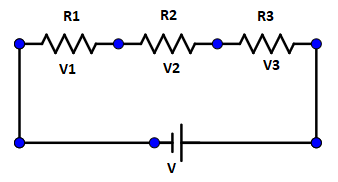
Give the law of combination of resistances in series.
Answer
469.8k+ views
Hint: Use the formula of the ohm law and find the potential difference across each resistor, from that find the total potential difference across the circuit. Derive the equal resistance across the circuit from the derived potential difference.
Useful formula:
The ohm’s law is given by
Where
Complete step by step solution:
Let us construct the circuit diagram in which the three resistors are connected in series. Since the resistors are connected in series, all the resistors have equal current flowing through them but their potential difference varies for each resistor connected in the circuit.

Let us add all the three potential differences to find the total potential difference developed in the circuit.
Substituting their parameters in the above equation, we get
Since the current is same in all the three resistors,
For the full circuit, the ohm’s law is substituted as follows.
Comparing the equation (1) and (2), we get
Hence the equivalent resistance is the sum of the resistance of the individual resistors connected in series. This is called by the name law of the combination of resistances in series.
Note: Remember that in a series circuit, the current flows through each resistor will be the same and the voltage and the resistance of the total circuit will be equal to the sum of the individual parameters. Parallel circuit is opposite to a series, in which the voltage is the same across the circuit and the current will be the sum of the current through the individual circuits.
Useful formula:
The ohm’s law is given by
Where
Complete step by step solution:
Let us construct the circuit diagram in which the three resistors are connected in series. Since the resistors are connected in series, all the resistors have equal current flowing through them but their potential difference varies for each resistor connected in the circuit.

Let us add all the three potential differences to find the total potential difference developed in the circuit.
Substituting their parameters in the above equation, we get
Since the current is same in all the three resistors,
For the full circuit, the ohm’s law is substituted as follows.
Comparing the equation (1) and (2), we get
Hence the equivalent resistance is the sum of the resistance of the individual resistors connected in series. This is called by the name law of the combination of resistances in series.
Note: Remember that in a series circuit, the current flows through each resistor will be the same and the voltage and the resistance of the total circuit will be equal to the sum of the individual parameters. Parallel circuit is opposite to a series, in which the voltage is the same across the circuit and the current will be the sum of the current through the individual circuits.
Recently Updated Pages
Master Class 12 Business Studies: Engaging Questions & Answers for Success

Master Class 12 English: Engaging Questions & Answers for Success

Master Class 12 Social Science: Engaging Questions & Answers for Success

Master Class 12 Chemistry: Engaging Questions & Answers for Success

Class 12 Question and Answer - Your Ultimate Solutions Guide

Master Class 11 Economics: Engaging Questions & Answers for Success

Trending doubts
Draw a labelled sketch of the human eye class 12 physics CBSE

a Tabulate the differences in the characteristics of class 12 chemistry CBSE

Which one of the following is a true fish A Jellyfish class 12 biology CBSE

Why is the cell called the structural and functional class 12 biology CBSE

Differentiate between homogeneous and heterogeneous class 12 chemistry CBSE

Write the difference between solid liquid and gas class 12 chemistry CBSE




